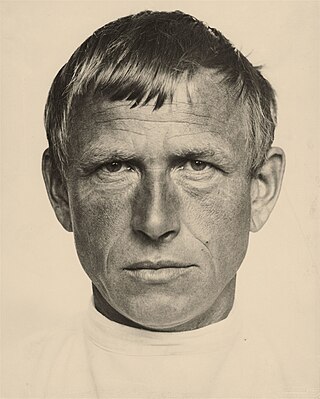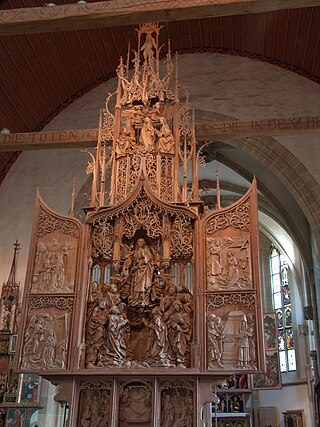Related Research Articles

Wilhelm Heinrich Otto Dix was a German painter and printmaker, noted for his ruthless and harshly realistic depictions of German society during the Weimar Republic and the brutality of war. Along with George Grosz and Max Beckmann, he is widely considered one of the most important artists of the Neue Sachlichkeit.

Emil Nolde was a German-Danish painter and printmaker. He was one of the first Expressionists, a member of Die Brücke, and was one of the first oil painting and watercolor painters of the early 20th century to explore color. He is known for his brushwork and expressive choice of colors. Golden yellows and deep reds appear frequently in his work, giving a luminous quality to otherwise somber tones. His watercolors include vivid, brooding storm-scapes and brilliant florals.

Expressionism is a modernist movement, initially in poetry and painting, originating in Northern Europe around the beginning of the 20th century. Its typical trait is to present the world solely from a subjective perspective, distorting it radically for emotional effect in order to evoke moods or ideas. Expressionist artists have sought to express the meaning of emotional experience rather than physical reality.

Degenerate art was a term adopted in the 1920s by the Nazi Party in Germany to describe modern art. During the dictatorship of Adolf Hitler, German modernist art, including many works of internationally renowned artists, was removed from state-owned museums and banned in Nazi Germany on the grounds that such art was an "insult to German feeling", un-German, Freemasonic, Jewish, or Communist in nature. Those identified as degenerate artists were subjected to sanctions that included being dismissed from teaching positions, being forbidden to exhibit or to sell their art, and in some cases being forbidden to produce art.

George Grosz was a German artist known especially for his caricatural drawings and paintings of Berlin life in the 1920s. He was a prominent member of the Berlin Dada and New Objectivity groups during the Weimar Republic. He emigrated to the United States in 1933, and became a naturalized citizen in 1938. Abandoning the style and subject matter of his earlier work, he exhibited regularly and taught for many years at the Art Students League of New York. In 1959 he returned to Berlin, where he died shortly afterwards.

The New Objectivity was a movement in German art that arose during the 1920s as a reaction against expressionism. The term was coined by Gustav Friedrich Hartlaub, the director of the Kunsthalle in Mannheim, who used it as the title of an art exhibition staged in 1925 to showcase artists who were working in a post-expressionist spirit. As these artists—who included Max Beckmann, Otto Dix, George Grosz, Christian Schad, Rudolf Schlichter and Jeanne Mammen—rejected the self-involvement and romantic longings of the expressionists, Weimar intellectuals in general made a call to arms for public collaboration, engagement, and rejection of romantic idealism.

Wols was the pseudonym of Alfred Otto Wolfgang Schulze, a German painter and photographer predominantly active in France. Though broadly unrecognized in his lifetime, he is considered a pioneer of lyrical abstraction, one of the most influential artists of the Tachisme movement. He is the author of a book on art theory entitled Aphorismes de Wols.

The Neue Galerie New York is a museum of early twentieth-century German and Austrian art and design located in the William Starr Miller House at 86th Street and Fifth Avenue in New York City. Established in 2001, it is one of the most recent additions to New York City's famed Museum Mile, which runs from 83rd to 105th streets on Fifth Avenue in the Upper East Side of Manhattan.
Rudolf Schlichter was a German painter, engraver and writer. He was one of the most important representatives of the critical-realistic style of verism within the New Objectivity movement. He also wrote some autobiographical books.

Otto Müller was a German painter and printmaker of the Die Brücke expressionist movement.

Georg Schrimpf was a German painter and graphic artist. Along with Otto Dix, George Grosz and Christian Schad, Schrimpf is broadly acknowledged as a main representative of the art movement Neue Sachlichkeit, which developed, in Weimar Germany, from 1919 to 1933, as an outgrowth of Expressionism. Schrimpf was listed as a producer of Degenerate Art by the German National Socialist government in the 1930s.
Daniel Richter is a German artist. He is based in Berlin, and was previously active in Hamburg. He is known for large-scale oil paintings.

German art has a long and distinguished tradition in the visual arts, from the earliest known work of figurative art to its current output of contemporary art.

Georg Scholz was a German painter, member of the New Objectivity movement.

The Berlin Secession was an art movement established in Germany on May 2, 1898. Formed in reaction to the Association of Berlin Artists, and the restrictions on contemporary art imposed by Kaiser Wilhelm II, 65 artists "seceded," demonstrating against the standards of academic or government-endorsed art. The movement is classified as a form of German Modernism, and came on the heels of several other secessions in Germany, including Jugendstil and the Munich Secession.

The Militant League for German Culture, was a nationalistic anti-Semitic political society during the Weimar Republic and the Nazi era. It was founded in 1928 as the Nationalsozialistische Gesellschaft für deutsche Kultur by Nazi ideologue Alfred Rosenberg and remained under his leadership until it was reorganized and renamed to the National Socialist Culture Community in 1934.
The Dresdner Sezession was an art group aligned with German Expressionism founded by Otto Schubert, Conrad Felixmüller and his pupil Otto Dix in Dresden, during a period of political and social turmoil in the aftermath of World War I. The group's activity spanned from 1919 until its final collective exhibition in 1925. During its heyday, the group consisted of some of the most influential and prominent expressionist artists of their generations, including Will Heckrott, Lasar Segall, Otto Schubert and Constantin von Mitschke-Collande, as well as the architect Hugo Zehder and writers Walter Rheiner, Heinar Schilling, and Felix Stiemer.
The Galerie Nierendorf is a commercial art gallery based in Berlin founded by Karl and Josef Nierendorf in 1920, and reopened in 1955 as the Galerie Meta Nierendorf by Florian and Inga Karsch.

Große Berliner Kunstausstellung , abbreviated GroBeKa or GBK, was an annual art exhibition that existed from 1893 to 1969 with intermittent breaks. In 1917 and 1918, during World War I, it was not held in Berlin but in Düsseldorf. In 1919 and 1920, it operated under the name Kunstausstellung Berlin. From 1970 to 1995, the Freie Berliner Kunstausstellung was held annually in its place.

The Love Sick is an oil on canvas painting by the German expressionist painter George Grosz, executed in 1916. The unsigned work is held at the Kunstsammlung Nordrhein-Westfalen, in Düsseldorf. It was bought from the New York gallery owner Richard L. Feigen, in 1979.